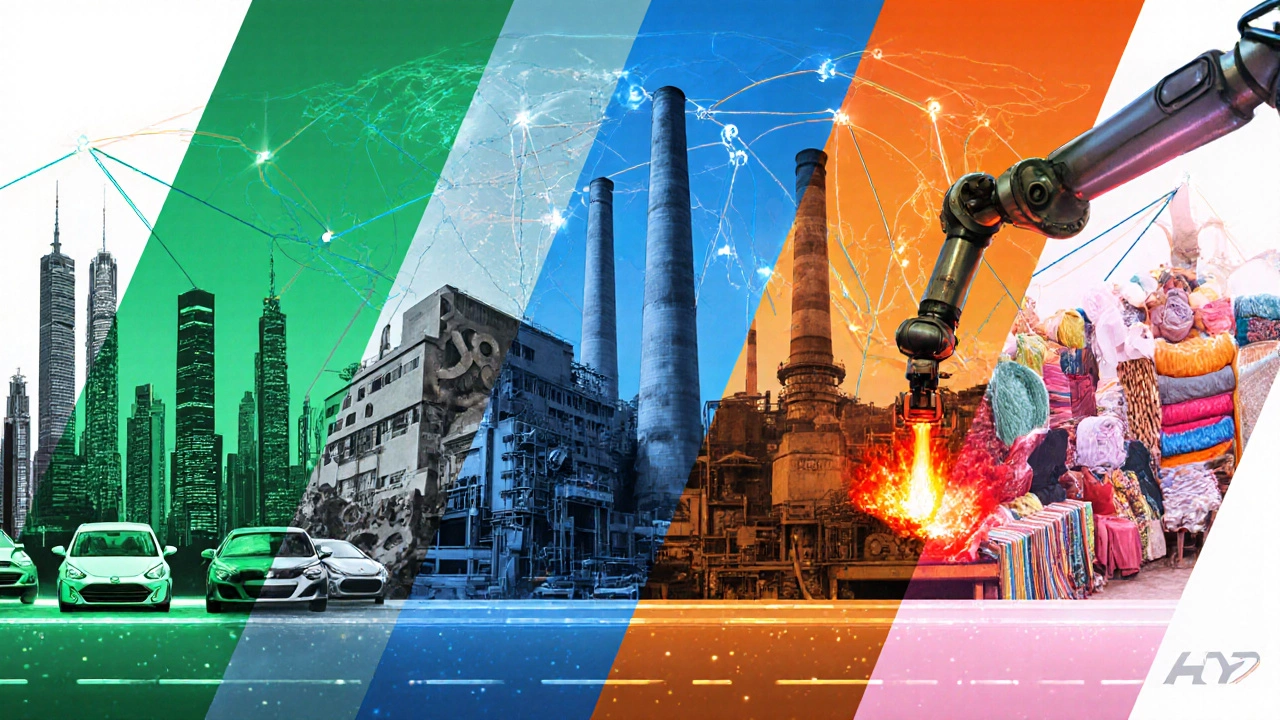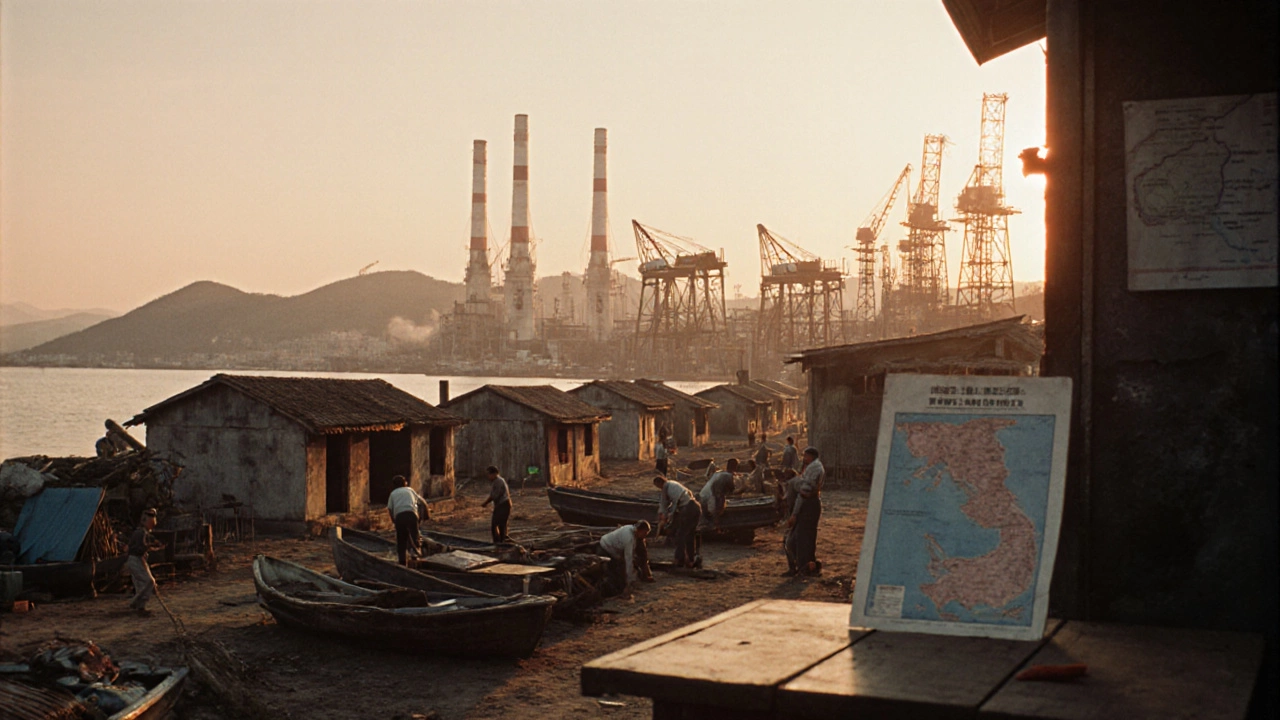Manufacturing Potential Calculator
Manufacturing Potential Assessment
Use this tool to evaluate a city's manufacturing potential based on the three key criteria from the article: Policy Environment, Supply Chain Proximity, and Talent & Infrastructure. Enter scores for each category (1-10 scale), then click "Calculate" to see your result.
Your Result
How Does This Compare?
| City | 2024 Output ($B) | Estimated Score |
|---|---|---|
| Shenzhen | 650 | 9.7 |
| Guangzhou | 420 | 8.4 |
| Detroit | 210 | 7.9 |
| Stuttgart | 190 | 7.6 |
| Monterrey | 145 | 7.2 |
| Ho Chi Minh City | 130 | 6.8 |
*Based on article data and typical scoring criteria
When you hear the phrase manufacturing capital, a single name usually pops up: Shenzhen is China's leading manufacturing hub, often called the world’s manufacturing capital. But the story behind that title is a mix of history, policy, and shifting global economics. Let’s unpack why Shenzhen earned the crown, how other regions are challenging its lead, and what government schemes are reshaping the map of production in 2025.
Why Shenzhen Became the Manufacturing Powerhouse
In the early 1980s, China rolled out the Special Economic Zones (SEZs). Shenzhen, a tiny fishing village just across the border from Hong Kong, was the first to get SEZ status. The government offered tax holidays, relaxed labor rules, and easy access to foreign capital. Within a decade, factories sprouted like mushrooms, churning out everything from toys to smartphones.
Three factors cemented Shenzhen’s dominance:
- Supply‑chain density: The city hosts an unmatched cluster of component manufacturers, PCB printers, and assembly lines. A smartphone maker can source a chip, a screen, and a case all within a 30‑minute drive.
- Talent pipeline: Universities such as Southern University of Science and Technology pump out engineers fluent in both hardware and software, feeding the rapid‑innovation cycle.
- Policy momentum: Initiatives like “Made in China 2025” push high‑value production, while the recent “Dual Circulation” strategy encourages domestic consumption of locally made goods.
According to the World Bank, Shenzhen’s manufacturing output topped US$650 billion in 2024, outpacing entire nations.
Emerging Counterparts: Cities That Are Giving Shenzhen a Run for Its Money
While Shenzhen still leads, several other cities are narrowing the gap. Below is a snapshot of the top contenders.
| City | Country | Key Industries | 2024 Output (US$ bn) | Signature Government Scheme |
|---|---|---|---|---|
| Shenzhen | China | Electronics, ICT, Robotics | 650 | Made in China 2025 |
| Guangzhou | China | Automobiles, Apparel, Machinery | 420 | Dual Circulation |
| Detroit | United States | Automotive, Advanced Materials | 210 | U.S. Inflation Reduction Act |
| Stuttgart | Germany | Automotive, Precision Engineering | 190 | Germany’s Industry 4.0 |
| Monterrey | Mexico | Steel, Aerospace, Electronics | 145 | Mexico 2023 Manufacturing Plan |
| Ho Chi Minh City | Vietnam | Textiles, Footwear, Electronics | 130 | Vietnam 2025 Industrial Strategy |
Notice how each city’s growth ties directly to a national or regional policy. That link tells us that the title of “manufacturing capital” isn’t static-it shifts with political will.

Government Schemes That Redefine the Landscape
Beneficial policies act like fertilizers for industrial clusters. Here are the top five schemes shaping today’s manufacturing map:
- Make in India - Launched in 2020, it offers capital subsidies, land‑allocation incentives, and a “digital‑first” procurement portal to attract foreign OEMs.
- Made in China 2025 - Targets high‑tech sectors, provides R&D tax credits, and pushes for domestic component sourcing.
- EU Industry 4.0 - A €100 billion program that funds smart‑factory pilots, AI integration, and green‑energy retrofits across member states.
- U.S. Inflation Reduction Act (IRA) - Grants tax credits for reshoring critical supply chains, especially batteries and semiconductors.
- Vietnam 2025 Industrial Strategy - Focuses on high‑value electronics, offers land‑lease discounts, and guarantees a stable utility rate for investors.
Each of these programs not only draws new factories but also upgrades existing ones, nudging cities up the manufacturing ranking ladder.
How to Evaluate a City’s Manufacturing Potential - A Quick Checklist
If you’re scouting locations for a new plant or partnership, use this three‑step framework:
- Policy Environment: Review current and upcoming government schemes. A city with a fresh incentive package often signals imminent growth.
- Supply‑Chain Proximity: Map the distance to key component suppliers. Shorter logistics chains lower cost and improve time‑to‑market.
- Talent & Infrastructure: Check university output in relevant engineering fields and assess logistics hubs (ports, rail, airports).
Applying the checklist to Shenzhen, you’ll see a perfect alignment - strong policy backing, dense component clusters, and world‑class metro/port connectivity.
Future Outlook: Will Shenzhen Keep the Crown?
Several trends could reshape the hierarchy in the next decade:
- Decoupling of US‑China tech supply chains: If restrictions tighten, manufacturers may relocate to Vietnam, India, or Mexico, eroding Shenzhen’s volume.
- Green manufacturing mandates: The EU’s Carbon Border Adjustment Mechanism could make European factories more attractive for low‑carbon products.
- Automation breakthroughs: As AI‑driven robotics lower labor cost differentials, cities with higher wages - like Stuttgart - could become more competitive.
Nevertheless, Shenzhen’s entrenched ecosystem gives it resilience. Even if its share falls from 15% of global output to 12% by 2035, it will likely remain the most referenced manufacturing capital.
Key Takeaways
- Shenzhen earned the title through early SEZ policies, a hyper‑dense supply chain, and relentless talent inflow.
- Emerging hubs such as Guangzhou, Detroit, Stuttgart, Monterrey, and Ho Chi Minh City are closing the gap, each powered by strong national schemes.
- Government initiatives like Make in India and the EU’s Industry 4.0 are the primary levers that shift manufacturing power.
- Use a three‑step checklist (policy, supply chain, talent) to assess any city’s manufacturing potential.
- Future shifts will hinge on geopolitical decoupling, green regulations, and automation - but Shenzhen’s ecosystem still gives it a solid lead for now.
Why is Shenzhen called the world’s manufacturing capital?
Shenzhen’s early SEZ status, massive component‑supplier density, and sustained government programs (e.g., Made in China 2025) have produced an annual output of over US$650 billion, more than any single city worldwide.
Which other cities rival Shenzhen in manufacturing?
Guangzhou (China), Detroit (USA), Stuttgart (Germany), Monterrey (Mexico), and Ho Chi Minh City (Vietnam) are top contenders, each backed by strong national policies and industry clusters.
What government scheme helps foreign investors in India?
The “Make in India” initiative offers capital subsidies, streamlined land allocation, and a digital procurement portal to attract overseas OEMs.
How does the EU’s Industry 4.0 program influence manufacturing hubs?
Industry 4.0 provides €100 billion in grants for smart‑factory pilots, AI integration, and low‑carbon upgrades, boosting the competitiveness of cities like Stuttgart and Leipzig.
What should a company check before setting up a new factory?
Apply the three‑step checklist: (1) evaluate the local policy and incentives, (2) verify proximity to key suppliers, and (3) assess talent pipelines and logistics infrastructure.
